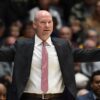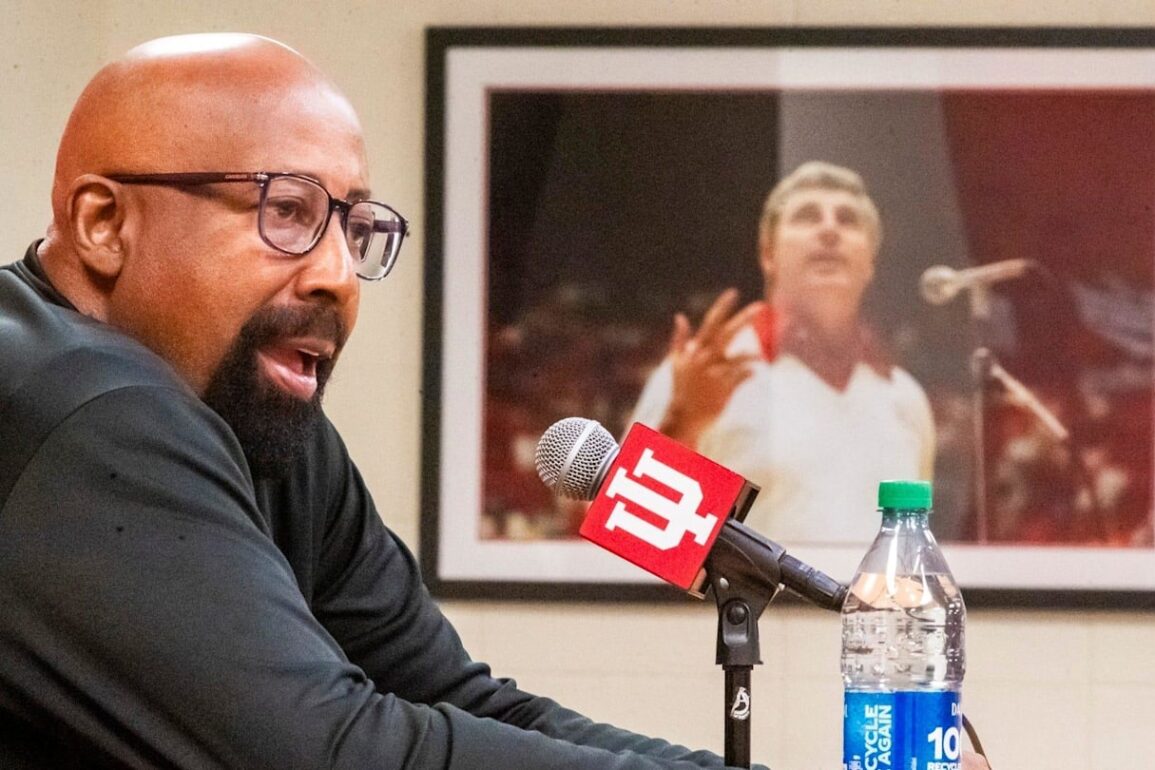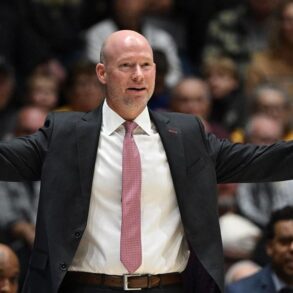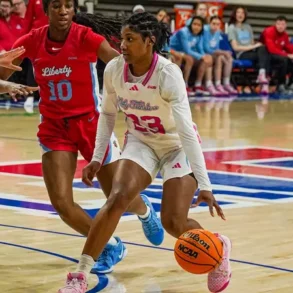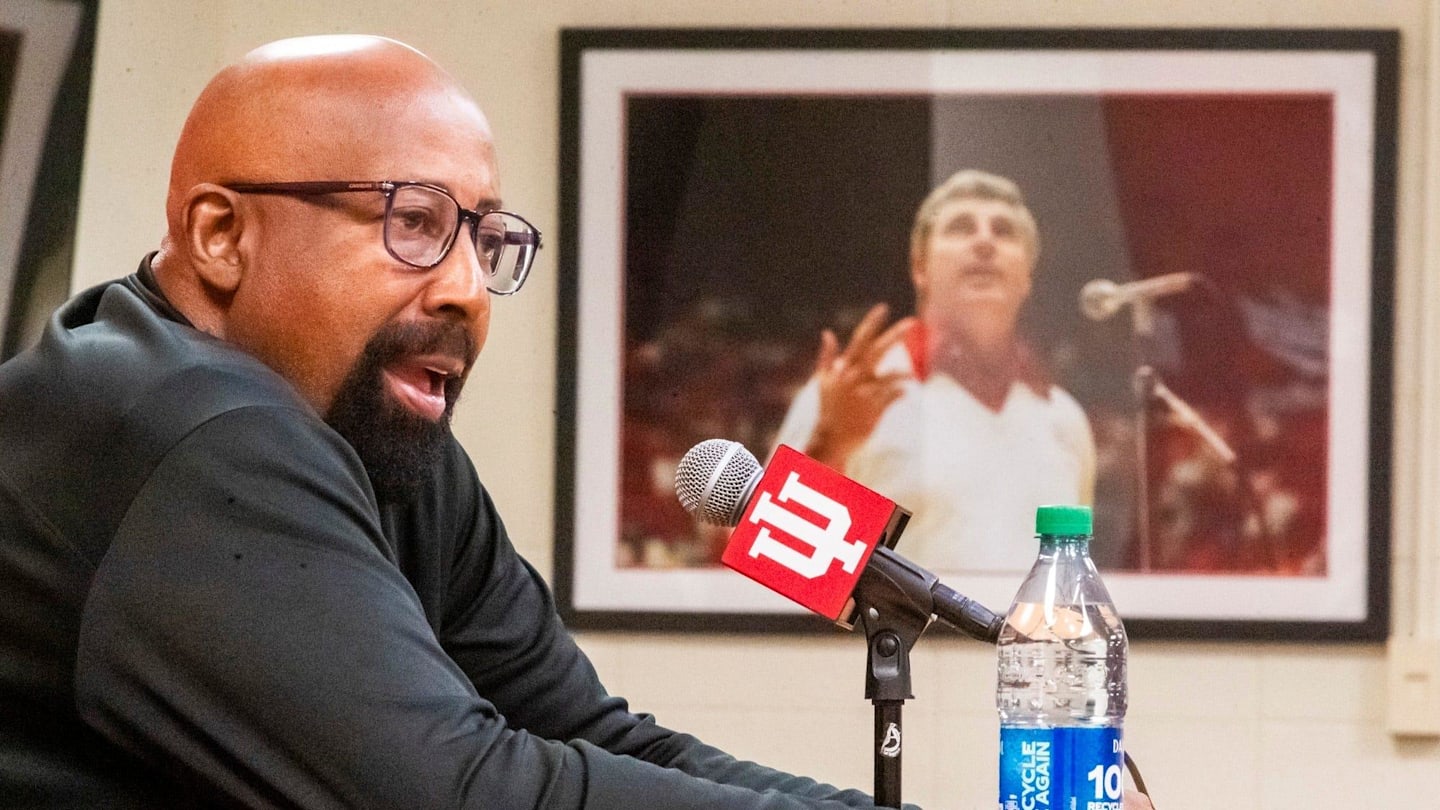
Much like his team on the floor, the end of Mike Woodson’s tenure as coach of the Indiana Hoosiers appears to be riddled with last-minute execution errors.
Reports started bubbling up Thursday afternoon that Woodson is ready to step down at the end of this season, his fourth on the job and second straight deeply disappointing one. But the news cycle is ahead of the university’s willingness to acknowledge it, leading to the program’s current state of suspended animation as everyone tries to figure out how to reach the end of this era.
Ultimately, it won’t matter. Woodson appears to be done at Indiana; it’s just a matter of the announcement phraseology and the buyout structure. And now one of the royalty programs of the sport will move on to its sixth attempt to find an adequate replacement for Bob Knight. His ghost all but haunts Assembly Hall.
Indiana’s malaise has been a perplexing failure stretching across a quarter of a century. The Hoosiers have tried pretty much everything, and nothing has worked over the long term.
Mike Davis was the emergency interim replacement when Knight was fired in September 2000, forcing the school’s hand by failing to abide by a conduct policy. Davis earned his shot at the full-time job by winning 21 games in a difficult spot, reaching both the Big Ten tournament final and NCAA tournament. In his first full-time season, Davis guided Indiana on a spectacular NCAA run to the national championship game, looking like the start of something big. That turned out to be the high point of his six-year tenure—and everything that followed.
Proven winner (and sinner) Kelvin Sampson was next up. He’s a great coach who won games, but violated the same NCAA rules he’d already broken at Oklahoma. With Knight’s legacy of rules compliance, Sampson had to go before his second season was over.
That gave way to nine years of Tom Crean, some of which were excellent after a slow rebuild. The 2012–13 team won the Big Ten title and earned a No. 1 NCAA seed, but fell apart against Syracuse’s zone in the Sweet 16. That missed opportunity for a Final Four left a stain that couldn’t be removed in the four seasons that followed.
Archie Miller was the reboot, a younger coach on the way up the ladder who took Dayton to four straight NCAA berths. Miller proved to be a bad fit, flailing through four unhappy seasons without a winning Big Ten record or an NCAA appearance (the Hoosiers probably would have been in the field in 2020, had there been a tournament).
Finally, Indiana played the alumni/nostalgia card and hired Woodson, an NBA coach and hero of the Knight era with no college coaching experience. That’s always an easy way to win the news conference, but often not the best way to win games. Whatever “healing” was accomplished with the Knight old guard turned into fresh wounds when everyone gradually realized Woodson wasn’t going to be any better than the five coaches who preceded him.
Across nearly four full seasons, Woodson’s .611 winning percentage is slightly better than Davis’s .592, Crean’s .552 and Miller’s .536. It’s worse than Sampson’s .741, which of course doesn’t factor in the NCAA sanctions that came after he was fired. Woodson was better than average but never good enough, with declining returns the past two seasons despite significant NIL resources at the program’s disposal.
This Indiana team is a well-paid mishmash of poor shooters and ballhandlers whose nine defeats have been an assortment of brutal blowouts and crushing late defeats. The first five losses—to Louisville, Gonzaga, Nebraska, Iowa and Illinois—all were by at least 15 points. The next three were by single digits, with a one-point home loss to Maryland marked by the Hoosiers’ inept final possession and a five-point loss at Purdue that seesawed back and forth.
The Purdue loss may have broken this team. Indiana no-showed the start of the next game, Tuesday at Wisconsin, falling behind 26–4. That set the program on the path to the unofficial ending that is awkwardly playing out now. And so the search for the next great coach continues.
Knight won three national championships and 11 Big Ten titles, setting a bar that may never be reached again at Indiana. But IU fans are not delusional or living in the past by expecting better than what they’ve gotten over the last two-plus decades. There’s no reason Indiana cannot be at least a periodic contender for national titles and Final Fours, and a regular contender in the Big Ten.
The program lacks nothing. There is institutional commitment, fan commitment, facilities and a home recruiting base. Even though regional talent procurement probably matters less now in the modern NIL and transfer world, it still matters. Look no further than a couple hours north of Bloomington, Ind., where the Purdue Boilermakers played for the national title last year with five in-state players in the eight-man rotation. Even without powerhouse Canadian Zach Edey, Purdue might win the Big Ten again with five in-state guys playing key roles.
Indiana just has to nail the hire. And the school did itself no favors by giving Woodson a fourth season and not doing it last year.
Dusty May was there for the wooing last season. A Hoosier native and alum who was a manager under Knight, he was far more than just a nostalgia hire—he was a fresh miracle worker after taking the Florida Atlantic Owls to the 2023 Final Four. May, who grew up less than 30 minutes from campus, is now the coach at Michigan.
An array of other upwardly mobile coaches were on the market as well. Louisville landed Pat Kelsey. West Virginia grabbed Darian DeVries. Vanderbilt got Mark Byington (who had worked at James Madison with current IU football savior Curt Cignetti). Indiana missed out on those guys as well.
Who knows, maybe May would heed the call to come home after just one year at Michigan. But it would be costly. In addition to the $8.4 million it will reportedly cost to buy out Woodson, May’s buyout after one season is $5 million. Factor in what Indiana is investing in Cignetti and the impending House v. NCAA settlement payments, and the Hoosiers would have to dig deep—and that’s if May would even be willing to leave Ann Arbor, Mich.
If Indiana wants to get a proven winner with a Final Four on his résumé who seems like he might be willing to relocate, call Mick Cronin. The UCLA Bruins coach is decidedly not thrilled by the cross-country travel onus upon his program in the Big Ten. At Indiana, the cross-country conference road trips would diminish from four per season to one.
Big Ten members Illinois, Michigan (twice), Ohio State (twice), Michigan State (five times), Wisconsin and Purdue all have made Final Fours in the last 20 years. If they can do it, Indiana can get there again and win it all. It simply has to get the right coach for the times—one willing to put in the work in the transfer and high school markets, one capable of coaching a modern style of play, one who can press the right buttons in close games.
Indiana basketball is not dead. It just has to reboot and try yet again.
More College Basketball on Sports Illustrated
This post was originally published on this site be sure to check out more of their content.


